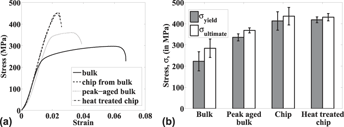Article contents
Tensile testing of Al6061-T6 microspecimens with ultrafine grained structure derived from machining-based SPD process
Published online by Cambridge University Press: 25 June 2014
Abstract

This paper discusses tensile testing of small samples of nanocrystalline Al6061-T6 alloy obtained from an unusual application of machining as a severe plastic deformation process. Ultrafine grained (UFG) shavings obtained from plane-strain cutting show higher hardness than the bulk material in agreement with existing literature. Application of restricted contact tools and extrusion-machining was explored to obtain shavings with minimum curvature to aid in tensile test specimen preparation. A novel method to prepare small tensile test specimens from these shavings has been described. During the tensile testing of UFG material, strains were measured using digital image correlation of natural speckles on the specimen. Specimens made from the UFG material had higher tensile strength and yield stress than the bulk, while ductility was lower. Lower values of Young's modulus were observed during the tensile testing of small specimens made from UFG as well as bulk material.
Keywords
- Type
- Articles
- Information
- Copyright
- Copyright © Materials Research Society 2014
References
REFERENCES
- 6
- Cited by


